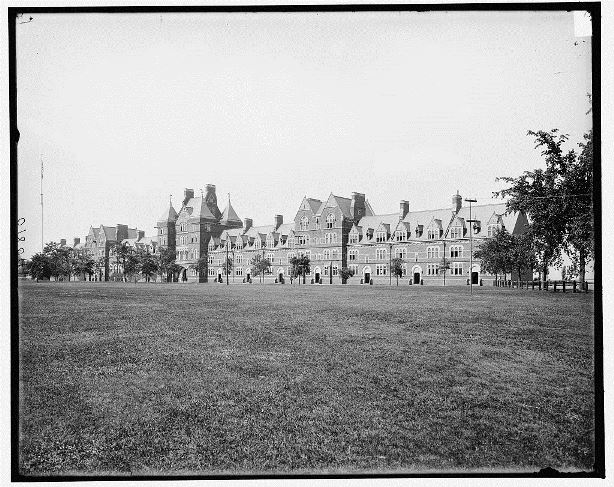In the spring of 1823, Connecticut opened Washington College in downtown Hartford and the Reverend Thomas Brownell served as its principal founder and first president. The college began with fewer than a dozen students and the first campus consisted of just two buildings: the first contained a chapel, library, and lecture halls, and the second served as a dormitory. Within a short time, enrollment grew to over 100 students, however, and the school quickly became an important part of the Greater Hartford community. In 1845 administrators changed its name to Trinity College.

Sir, your attendance is respectfully requested at an examination of the students of Washington College…, 1827. Broadsides S 1826 T833s — Connecticut Historical Society
Trinity College leaves Downtown Hartford
In 1872, the future of Trinity College forever changed when the City of Hartford purchased campus lands from Trinity trustees in order to build Connecticut’s new state capitol. Plans for a new Trinity campus soon took shape, however, and the college retained famed Victorian architect William Burges to design it. Six years later, in 1878, Trinity College moved to its current location. Most of Burges’s original plans proved too ambitious and too expensive and were never finished, although one section, the Long Walk, which includes Seabury and Jarvis Halls and the Northern Towers, did reach completion and still serves as a reminder of “the medieval origins of collegiate institutions.”
By the start of the 20th century, Trinity’s appeal increasingly attracted new students from outside the Hartford area. The new century also brought new ways of thinking and the curricula expanded to include areas of study such as biology and other natural sciences. In 1968, the Trinity College trustees withdrew from the Association of Episcopal Colleges and the following year the college became coeducational, admitting its first class of female students.
Today, Trinity College is affectionately referred to as a “Mini-Ivy” by locals and continues to serve the Hartford community in many ways far beyond academics. Located in a highly dense urban community, the college is part of the Southside Institutions Neighborhood Alliance and partners with the Learning Corridor, the Institute of Living, and Hartford Hospital to create affordable housing in the nearby Barry Square and Frog Hollow neighborhoods. The college also created the Trinity College Boys and Girls Club and opens their library, computer center, and sports complex to Hartford residents.










